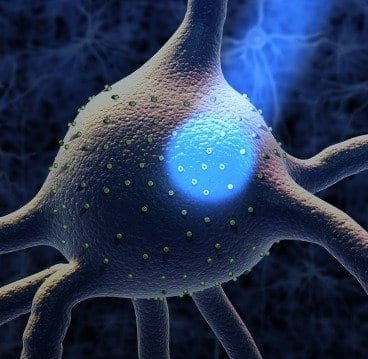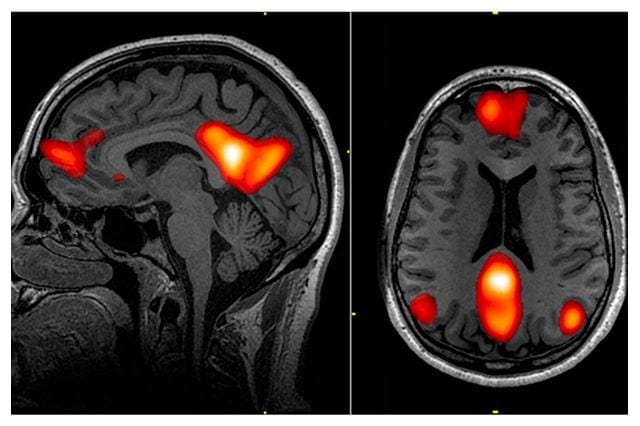
About 1 percent of U.S. adults suffer from OCD, and patients usually receive antianxiety drugs or antidepressants, behavioral therapy, or a combination of therapy and medication
By activating a brain circuit that controls compulsive behavior, MIT neuroscientists have shown that they can block a compulsive behavior in mice — a result that could help researchers develop new treatments for diseases such as obsessive-compulsive disorder (OCD) and Tourette’s syndrome.
About 1 percent of U.S. adults suffer from OCD, and patients usually receive antianxiety drugs or antidepressants, behavioral therapy, or a combination of therapy and medication. For those who do not respond to those treatments, a new alternative is deep brain stimulation, which delivers electrical impulses via a pacemaker implanted in the brain.
For this study, the MIT team used optogenetics to control neuron activity with light. This technique is not yet ready for use in human patients, but studies such as this one could help researchers identify brain activity patterns that signal the onset of compulsive behavior, allowing them to more precisely time the delivery of deep brain stimulation.
“You don’t have to stimulate all the time. You can do it in a very nuanced way,” says Ann Graybiel, an Institute Professor at MIT, a member of MIT’s McGovern Institute for Brain Research and the senior author of a Science paper describing the study.
The paper’s lead author is Eric Burguière, a former postdoc in Graybiel’s lab who is now at the Brain and Spine Institute in Paris. Other authors are Patricia Monteiro, a research affiliate at the McGovern Institute, and Guoping Feng, the James W. and Patricia T. Poitras Professor of Brain and Cognitive Sciences and a member of the McGovern Institute.
Controlling compulsion
In earlier studies, Graybiel has focused on how to break normal habits; in the current work, she turned to a mouse model developed by Feng to try to block a compulsive behavior. The model mice lack a particular gene, known as Sapap3, that codes for a protein found in the synapses of neurons in the striatum — a part of the brain related to addiction and repetitive behavioral problems, as well as normal functions such as decision-making, planning and response to reward.
For this study, the researchers trained mice whose Sapap3 gene was knocked out to groom compulsively at a specific time, allowing the researchers to try to interrupt the compulsion. To do this, they used a Pavlovian conditioning strategy in which a neutral event (a tone) is paired with a stimulus that provokes the desired behavior — in this case, a drop of water on the mouse’s nose, which triggers the mouse to groom. This strategy was based on therapeutic work with OCD patients, which uses this kind of conditioning.
The Latest Bing News on:
OCD treatments
- Lisburn teen calls for more understanding of obsessive compulsive disorderon April 28, 2024 at 8:29 am
Megan Green believes more supported and understanding is needed to help those whose lives have been taken over by the condition ...
- A closer look at OCDon April 27, 2024 at 9:10 pm
From the outside, obsessive-compulsive disorder (OCD) might seem like a simple case of being overly tidy or organised, but it goes far deeper than just cleanliness. It's a complex disorder ...
- Obsessive-Compulsive (OCD) Treatment Centers in Wheat Ridge, COon April 26, 2024 at 12:07 pm
Medication can be used to treat OCD. The class of drugs most often prescribed are selective serotonin reuptake inhibitors, or SSRIs, which include fluvoxamine (under the brand name Luvox ...
- Novelist John Green says OCD is like an 'invasive weed' inside his mindon April 26, 2024 at 10:42 am
Green's YA novel, Turtles All The Way Down, has been recently adapted to film. Green described living with OCD, and how "one little thought" could take over his mind, in this 2017 interview.
- Avoidance Predicts Worse Long-term Outcomes from Intensive OCD Treatmenton April 23, 2024 at 7:03 am
Behavioral avoidance could limit the long-term of a widely used treatment for obsessive compulsive disorder, a new analysis shows.
- Georgia doesn't treat this devastating diagnosis in kids | How families are navigating careon April 22, 2024 at 3:00 am
Families whose children are diagnosed with PANS or PANDAS say they cannot find medical providers who will treat their kids.
- OCD bats for youth's increased role in SDGs attainmenton April 18, 2024 at 7:54 pm
The Office of Civil Defense (OCD) underscored the importance of the youth's active participation in attaining the United Nations' (UN) Sustainable Development Goals (SDGs), particularly disaster risk ...
- Florida Full Service Medication Management & Therapy Center For OCD Announcedon April 17, 2024 at 7:06 pm
Calusa Recovery (+1 866 939 6292) offers full service medication management recovery programs and therapies for people with OCD or other mental health disorders. The recently announced mental health ...
- What Is Transcranial Magnetic Stimulation (TMS) Therapy?on April 17, 2024 at 3:01 am
in 2008 for the treatment of major depressive disorder (MDD), though recent research suggests it may be effective for obsessive compulsive disorder (OCD), anxious depression, smoking cessation and ...
- Exploring a Seeming Paradox: Pioneering Map Reveals Pathways to Treating Neurological Disorderson April 16, 2024 at 1:27 am
Researchers employ deep brain stimulation to localize disrupted neural pathways. When certain connections in the brain malfunction, conditions like Parkinson's disease, dystonia, obsessive-compulsive ...
The Latest Google Headlines on:
OCD treatments
[google_news title=”” keyword=”OCD treatments” num_posts=”10″ blurb_length=”0″ show_thumb=”left”]
The Latest Bing News on:
Obsessive-compulsive disorder
- Lisburn teen calls for more understanding of obsessive compulsive disorderon April 28, 2024 at 8:29 am
Megan Green believes more supported and understanding is needed to help those whose lives have been taken over by the condition ...
- Anxiety Disorder Treatment Market Towards US$ 15.89 Bn By 2030 | Rising Mental Health Awareness And New Therapeutic Options Driving Market Growthon April 27, 2024 at 9:31 pm
Technological Innovations: Technological advancements, such as telemedicine and digital therapeutics, have revolutionized the delivery of anxiety disorder treatments, enhancing accessibility and ...
- Living with obsessive compulsive disorderon April 26, 2024 at 10:02 am
It's Now or Never like you've never heard it before. Host Trevor Dineen reveals that he's been living with obsessive compulsive disorder - or OCD - since he was 21 years old. It's a debilitating ...
- Understanding the Different Types of Anxiety Disorderson April 26, 2024 at 8:44 am
There are several types of anxiety disorders, and knowing which you're experiencing can help treat it. Here are the most common types and what to know about each.
- MindMed: Breakthrough Status From The FDA For LSD Therapyon April 26, 2024 at 2:33 am
MindMed's LSD tartrate receives breakthrough therapy designation from the FDA for the treatment of generalized anxiety disorder. See why MNMD stock is a Sell.
- No, you’re not ‘so OCD’on April 24, 2024 at 8:14 pm
It is important to destigmatize mental health, and there is power in conversation. However, accepting the existence and impact of mental illness should not mean taking it less seriously — and ...
- Mother of child with eating disorder calls for hospital system reform after 25 admissions in past yearon April 23, 2024 at 7:25 pm
Vanessa never thought her child's reduced food intake would turn into a long-term, life-threatening eating disorder. Now, after 25 hospital visits in the past year, she's calling for more long-term ...
- Student, 21, lives with excruciating ‘persistent genital arousal disorder’ that started with ‘pins and needles’on April 23, 2024 at 7:14 am
A STUDENT has told of the reality of living with an excruciating condition which leaves her permanently aroused. Scarlet Kaitlin Wallen was just six-years-old when she began to feel severe and ...
- Avoidance Predicts Worse Long-term Outcomes from Intensive OCD Treatmenton April 23, 2024 at 7:03 am
Behavioral avoidance could limit the long-term of a widely used treatment for obsessive compulsive disorder, a new analysis shows.
- ‘He’s quit talking to me’: My father, 83, suffers from hoarding disorder and dementia. How can I help him and protect his estate?on April 21, 2024 at 9:45 am
Your father is grappling with a lot of mental-health issues. Cognitive decline can change a person’s personality, resulting in sudden mood swings, becoming withdrawn or suspicious of other people, and ...
The Latest Google Headlines on:
Obsessive-compulsive disorder
[google_news title=”” keyword=”obsessive-compulsive disorder” num_posts=”10″ blurb_length=”0″ show_thumb=”left”]










